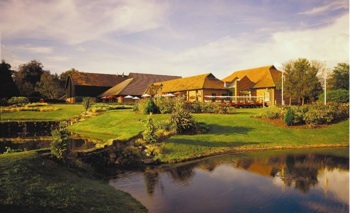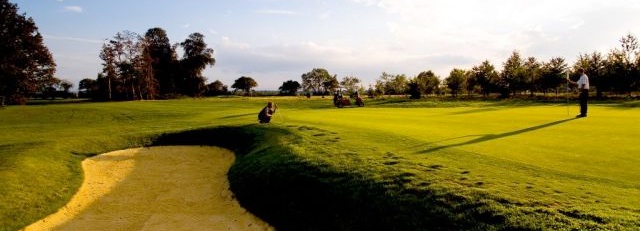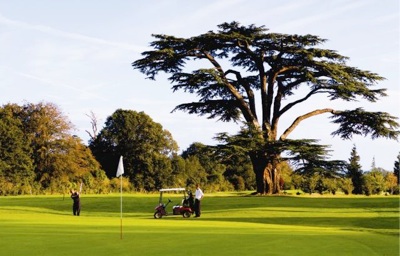Goodwood Downs Review
 The name Goodwood is synonymous with motor and horse racing, and those two leisure pursuits remain high up on its extensive list of attractions. But in recent times, it’s also made a foray into a different market: golf. The sport is etched into the history of the Goodwood Estate, and the property’s initial course dates back more than 100 years, but it’s a different, more modern layout that tends to create more of a stir. There are two golf courses at Goodwood – the Parks and the Downs – and while the former presents an enjoyable test for higher handicappers, it’s the latter that tends to make the headlines.
The name Goodwood is synonymous with motor and horse racing, and those two leisure pursuits remain high up on its extensive list of attractions. But in recent times, it’s also made a foray into a different market: golf. The sport is etched into the history of the Goodwood Estate, and the property’s initial course dates back more than 100 years, but it’s a different, more modern layout that tends to create more of a stir. There are two golf courses at Goodwood – the Parks and the Downs – and while the former presents an enjoyable test for higher handicappers, it’s the latter that tends to make the headlines.
The Downs is situated five minutes away from the grounds of the Goodwood Hotel, which contain the Parks, an all-encompassing leisure and spa resort and two quality dining establishments serving a mixture of comfort food and exquisite dishes made up of ingredients from the estate’s organic farm. The Downs, though, also has a claim to fame. It sits in the shadow of the elaborate Kennels – a grand structure originally built by the 3rd Earl of Richmond for his hounds – which doubles as the course’s clubhouse. It sits majestically in the 17,000-acre estate and provides some welcome respite after a round on a long, undulating but sublime golf course.
The Downs is a wonderfully varied and tranquil golf course that’s been carved seamlessly through valleys and woodland. It rises and falls over the tree-strewn terrain, creating a number of memorable and varied holes as it cascades along. The beauty of the terrain and exquisite views of the Sussex countryside (you can see the sea from the 6th tee on a clear day) are complemented by an excellent yet tough golf course made difficult by shrewd bunkering, slick, sloping greens with run-off areas, tree-lined fairways and a number of uphill and downhill approaches.

Front nine
The first six holes on the Downs present an exacting start, but I’d have to say it’s my favourite start to any golf course in the UK. The first is a secluded mid-range par 3 that should reward good shots with an opening par, but things become more taxing from the second – a hole that has to be one of the most unique in the country.
The fairway runs about around 230 yards from the tee, and placement is key. Play too conservative and you’ll be left with a blind second; get too aggressive and you’ll lose your ball in shrubland that appears as the hole dives dramatically downhill towards the green. The putting surface sits some 100 yards, if not more, below the level of the fairway, and unless you’re in the ideal spot, you won’t have a sight of it. It’s an inimitable hole made even better by the fact that, if you haven’t played the Downs before, you have no idea what awaits.
The third and fourth – a par 4 and par 5 respectively – are two of my favourite holes on the golf course. They are both carved through a V-shaped valley, surrounded on both sides by almost impenetrable woodland, and both possess raised, well-protected greens. The third is arguably easier to hit, while the fourth – a three-tiered upturned saucer with grassy banks and deep bunkers lurking ominously nearby – will leave your marvelling at the design in spite of your score. The theme of tricky green complexes continues on to the next hole, a short dogleg left that swings uphill from the apex. The green is raised considerably and framed beautifully by dense woodland on three sides.
After the sixth – a driveable par 4 presenting panoramic views over the course, coastline and surrounding countryside – the Downs opens up and assumes more of a parkland feel. The final three holes on the front nine are pleasant, if unspectacular, holes, starting and finishing with mid-length downhill par 4s where assessing distance control on approaches in troublesome.
 Back nine
Back nine
The back nine on the Downs starts with a testing uphill par 4 before the excellent par-5 11th, arguably the best hole on the course. The tee sits on top of a hill, offering wonderful views over the rolling Sussex countryside. It’s a very enticing tee shot, with the fairway sloping dramatically downhill before turning sharply uphill around the 300-yard mark. If you hit a good drive, you’ll be in a position to carry a series of cross bunkers that sit some 80 yards short of the putting surface. It’s a risk, though, as you’ll struggle to get down in three from these devilish and deep traps. If you’re successful, a little pitch remains to a tricky green that’s surrounded on all sides by sand and run-off areas. It’s a great hole that tests your bravery, skill and course management.
The following hole is a short downhill par 3, and the 13th, 14th and 15th are excellent mid-range par 4s that demand accurate tee shots. After playing the par-5 16th, you cross back under a bridge to take on the final two holes, which present a very challenging finish to the golf course. The 17th is a beautiful yet hazardous par 3 and the only hole on the course where water is a factor. It’s around 200 yards from the back tees, and any shot leaked even slightly right will be enveloped by a large pond that lurks to the front right of the putting surface. It’s the toughest par 3 on the course by a considerably distance.
The 18th is another challenging closing hole. The fairway is flanked on both sides by a collection of bunkers that protect the driving area, and trees that will snaffle very wayward drives. If you manage to dissect the trouble, you’ll still have a long iron or fairway wood to a relatively small green that’s framed beautifully by mature trees and rough-strewn banks. It’s a great finish hole and one of the toughest par 4s on the golf course.
The Downs at Goodwood is a wonderful, testing and varied golf course in the most serene of locations, with an opening stretch that’s as good as you’ll find anywhere in the UK. Overall, I’d give the course a rating of 7.5/10.
Related Content:

















